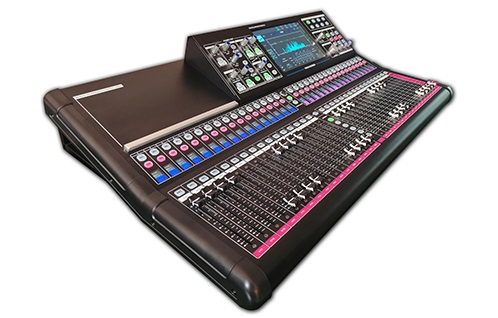Understanding the Expansion Options of Digital Mixers
Digital mixers have revolutionized the way audio professionals manage sound. These mixers offer incredible flexibility, high-quality processing, and a wide range of features to suit various needs. However, one of their most compelling advantages is their ability to expand and adapt to evolving requirements. Whether you’re setting up for live performances, studio recording, or multi-room audio systems, understanding the expansion options of digital mixers is essential to maximizing their potential and future-proofing your investment.

What Makes Digital Mixers Expandable?
Unlike traditional analog mixers, digital mixers are designed with scalability in mind. They often include features that allow users to add more channels, enhance processing power, or integrate seamlessly with other devices. These expansion capabilities make digital mixers versatile tools that can grow alongside your audio setup.
Key Expansion Options for Digital Mixers
1. Channel Expansion
One of the most common ways to expand digital mixers is by increasing their channel count. This allows you to accommodate more input sources, such as microphones, instruments, or playback devices.
Methods for Channel Expansion:
- Digital Stage Boxes: Connect external stage boxes to add additional inputs and outputs. These boxes often use protocols like Dante, AVB, or AES50 for seamless integration.
- Modular Designs: Some digital mixers come with slots for expansion cards, enabling you to add extra channels or connectivity options.
- Submixers: Use a secondary mixer connected to your primary digital mixer for additional channels.
2. Networking and Audio Protocols
Modern digital mixers often support networking protocols that allow for greater flexibility and scalability.
Popular Networking Protocols:
- Dante: A widely used protocol that supports high-channel audio over Ethernet. With Dante, you can connect multiple devices, including mixers, amplifiers, and recording systems, into a single network.
- AVB (Audio Video Bridging): Offers low-latency audio transmission and is ideal for live sound setups.
- AES50: Found in many mixers from brands like Midas and Behringer, this protocol allows for high-speed, low-latency connections.
Networking capabilities enable you to integrate additional equipment without sacrificing audio quality or reliability.
3. Remote Control and Software Integration
Another significant expansion option for digital mixers is remote control functionality. With the right software or apps, you can control your mixer from a laptop, tablet, or smartphone.
Benefits of Remote Control:
- Enhanced Workflow: Adjust levels, EQ, or effects from anywhere in the venue.
- Multi-User Control: Allow multiple users to control different aspects of the mix simultaneously.
- Integration with DAWs: Many digital mixers can connect directly to digital audio workstations, enabling streamlined recording and mixing.
4. Effects and Processing Expansion
Out-of-the-box, most digital mixers come with built-in effects and processing options. However, you can often expand these features to suit your needs.
Ways to Expand Effects and Processing:
- Plug-Ins: Some mixers allow you to install additional effects plug-ins for advanced processing.
- Outboard Gear: Connect external effects processors or dynamic controllers via auxiliary sends and returns.
- Firmware Updates: Manufacturers frequently release firmware updates that add new features or improve existing ones.
5. Multi-Track Recording and Playback
Many digital mixers include basic recording capabilities, but their expansion options can significantly enhance this functionality.
Multi-Track Recording Options:
- USB Interface: Connect the mixer to a computer for multi-track recording into a DAW.
- SD Card Slots: Record directly onto an SD card for easy playback and portability.
- External Recorders: Link the mixer to external multi-track recorders for high-capacity recording.
6. Integration with Wireless Systems
Wireless integration is an increasingly popular expansion feature for digital mixers, especially in live sound environments.
Examples of Wireless Integration:
- In-Ear Monitors (IEMs): Use wireless IEM systems for performers while managing mixes directly from the digital mixer.
- Microphones: Pair with wireless microphone systems for a cleaner stage setup.
- Remote Control Apps: Manage the mix wirelessly via dedicated control apps on mobile devices.
Choosing the Right Digital Mixer for Expansion
Assess Your Current Needs
Start by identifying your current setup and the number of channels or features you require. A smaller mixer with expansion capabilities might suffice if you’re just starting.
Plan for Future Growth
If you anticipate growing your audio setup, choose a digital mixer with robust expansion options, such as modular designs or networking capabilities.
Brand and Compatibility
Not all expansion options are universally compatible. Stick with a brand that offers a wide range of compatible accessories and protocols to ensure seamless integration.
Popular Digital Mixers with Great Expansion Capabilities
Behringer X32
The Behringer X32 is a versatile digital mixer known for its extensive expansion options, including AES50 networking, stage boxes, and remote control capabilities.
Yamaha TF Series
Yamaha’s TF mixers offer multi-track recording, DAW integration, and support for Dante networking, making them ideal for scalable setups.
Allen & Heath Qu Series
The Allen & Heath Qu series combines intuitive design with features like USB multi-track recording, remote apps, and stage box compatibility.
Tips for Maximizing the Expansion Options of Digital Mixers
- Stay Updated: Regularly update your mixer’s firmware to access new features and enhancements.
- Use High-Quality Cables: Reliable cables ensure the best performance when connecting stage boxes or other peripherals.
- Optimize Network Setup: For networked systems, use managed switches and configure VLANs for better performance.
- Experiment with Configurations: Test different expansion setups to find what works best for your workflow.
Understanding the Expansion Options of Digital Mixers
The ability to expand and adapt makes digital mixers a valuable investment for any audio professional. By exploring options like channel expansion, networking, and advanced processing, you can customize your mixer to meet your unique needs. Whether you’re working in a studio, managing live performances, or building a multi-room audio system, choosing a digital mixer with robust expansion capabilities ensures your setup remains flexible and future-proof.
Investing in a scalable digital mixer not only enhances your current audio experience but also prepares you for future challenges, allowing you to tackle larger projects with confidence. With the right planning and tools, the possibilities are virtually endless.